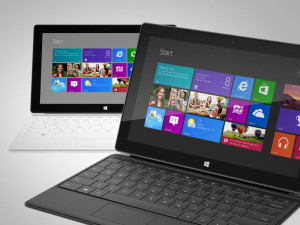Microsoft’s slow expansion of commercial sales of its struggling Surface line is proof that the company had no backup plan after completely misreading the market, an analyst said today.
“This goes back to their gross miscalculation,” said Patrick Moorhead of Moor Insights & Strategy. “This goes back to their belief that customers want what they think they delivered. They thought they would sell a ton of Surface RTs in the holiday season [of 2012] and that Surface Pro would just fly off the shelves.”
And when that didn’t happen, Microsoft was at a loss. “They didn’t have a Plan B,” Moorhead said.
Moorhead was referring to the deliberate pace Microsoft has taken in getting Surface into the hands of corporate customers. Last week the Redmond, Wash. company announced it would start selling Surface in Canada and 16 countries in Europe through a two-tier scheme, where a limited number of distributors will sell to selected resellers. Those resellers, in turn, were authorized to sell Surface to commercial accounts, such as businesses, government agencies and schools.
That move was a follow-up to one in the U.S. last month, when several partners were given the go-ahead to sell Surface devices.
But in an Aug. 15 blog announcing the expansion into Europe and Canada, Cyril Belikoff, the company’s marketing director for Surface, used the words “thoughtful” and “measured” to describe the distribution tempo.
“Our plan has been to expand commercial distribution for Surface in a thoughtful way,” said Belikoff (emphasis added). “This measured approach helps us to quickly gather feedback and improve while we grow our geographical reach in the business channel.”
Words like “thoughtful” and “measured” don’t impart any sense of urgency, which seems odd, well, on the surface, since Microsoft’s tablets are, by all accounts, barely breathing.
According to estimates by researcher IDC, Microsoft shipped just 300,000 Surface RT and Surface Pro tablets in the second quarter, which ended June 30. In the same period, Apple shipped 14.6 million iPads, while Android tablet makers shipped 28.2 million devices.
Windows’ portion of the second quarter’s tablet market was 4.5% — up from the previous quarter’s 3.7% — but most of those were devices from Microsoft’s OEM partners. Microsoft’s Surface accounted for just 15% of all Windows-powered tablets, or only 0.7% of the total of all tablets.
In other words, for every 1,000 tablets of all kinds shipped last quarter, 7 were Surface devices.
Moorhead traced Microsoft’s lack of urgency to its inability to quickly shift strategy.
“‘Measured’ and ‘thoughtful’ are code for ‘limited distribution.’ It’s not smart to blast it out to everyone in every channel, especially when 80% of the business is going through the resellers and distributors they announced,” said Moorhead. “If Microsoft had sold Surface as it expected, we would be saying, ‘This is just more volume.'”
But Microsoft did not sell Surface RT and Surface Pro in anything like the volumes it had anticipated.
When faced with that, Microsoft stuck with its pre-planned timetable for distributing the Surface to enterprises rather than pick up the pace, even though businesses and resellers have clamored for ways to buy and sell the tablets since their introduction.
Granted, Microsoft was starting from scratch in creating a business-first hardware distribution channel, something it had never done before. “It is hard for any company, much less one that’s never been in the systems business, to expand distribution,” said Moorhead, who years before he became an analyst worked for Compaq, the PC maker that was acquired by HP in 2002 for $25 billion.
“Microsoft is a mammoth company, but they’re novices in the systems business,” Moorhead observed.
Microsoft’s miscalculation of Surface sales has been well documented, even acknowledged by the company in July when it took a $900 million charge against earnings to discount excess inventory of the Surface RT. “It tells the story like nothing else does,” Moorhead said.
Moorhead blamed Microsoft for vastly underestimating the role a robust app ecosystem plays in the success of mobile devices, tablets included.
When the Surface RT launched last October, the Windows Store had just 9,000 apps, and even 10 months later it lacks critical “must-have” apps like Facebook, Google Maps, Instagram, LinkedIn and YouTube.
“It’s as if it was a music service that played only one genre, or a television that only showed news,” said Moorhead of the Surface’s crippling app gap.
Microsoft seemed to think that that wouldn’t matter, and that customers would beat a path to its door simply because it had shipped a tablet sporting Windows. “I think this has been a rude awakening for them,” said Moorhead.
And while he credited Microsoft with sticking with the Surface — most analysts and pundits expect the company to unveil new models this fall, including smaller 8-in. tablets — he wasn’t sure that the company would be able to pick out lessons from the first-year failure.
“The debacle with the Surface was so big that it may be difficult for them to learn from it,” Moorhead said. “When something goes that deep, with multiple elements that contribute to a failure, it’s often hard to isolate what actually happened. I don’t know if I learned as much from very large mistakes as I did over a series of small mistakes.”
And he wondered if the move into commercial distribution, though clearly necessary, wouldn’t prove to be another mistake.
“For the first time, this places Microsoft in a commercial hardware war with Dell, HP and Lenovo on corporate notebooks and tablets,” Moorhead said of the distribution channel initiatives. “This will further distance Microsoft from their PC OEMs and push them even further into the hands of Google. Over time, if Microsoft is too successful in poaching business from Dell, HP and Lenovo, it could become financially unviable [for them] to keep investing in Microsoft.”





